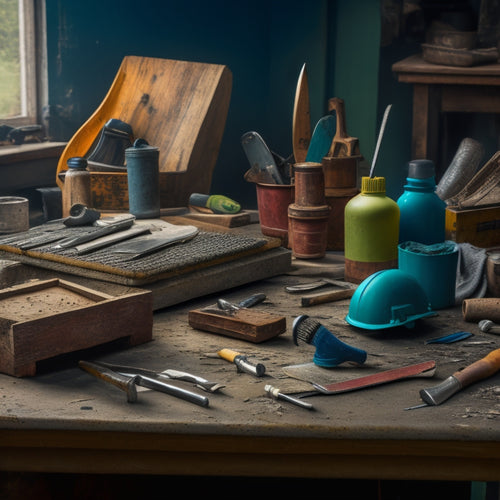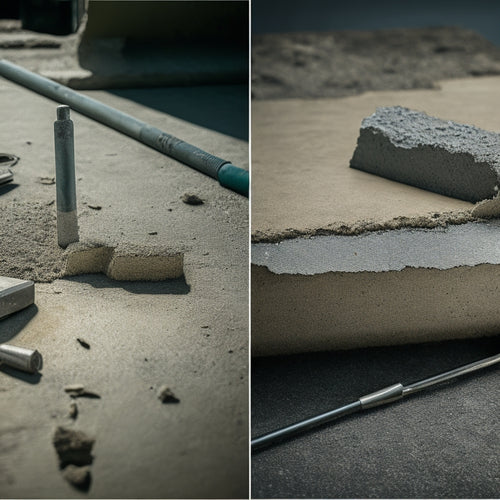
Selecting the Best Tools for Concrete Wall Sealing
Share
When selecting the best tools for concrete wall sealing, you'll need to assess your wall's specific needs, considering factors like surface deterioration, water damage, and maintenance history. Choose tools that align with your sealing technique and application method, such as sprayers, rollers, and brushes. Don't forget essential tools like edging tools, squeegees, and buckets. With the right tools, you'll be well-equipped to tackle your concrete wall sealing project. As you move forward, you'll discover the importance of surface preparation, safety precautions, and budget-friendly options, all of which will contribute to a successful sealing job.
Key Takeaways
- Assess the concrete wall's surface, maintenance history, and environmental exposure to determine the best sealing approach.
- Choose the right sealing tools based on the required application method, surface preparation, and sealant type.
- Select the appropriate sealant type (acrylic, polyurethane, epoxy, silicone, or penetrating) for the specific concrete wall sealing project.
- Wear personal protective equipment and follow safety precautions to ensure a safe and successful sealing process.
- Prepare the workspace by clearing debris, ensuring good ventilation, and following manufacturer's instructions for handling and mixing sealants.
Assessing Your Concrete Wall Needs
You need to evaluate the condition of your concrete wall to determine the best approach for sealing. Analyzing your wall's needs involves identifying any cracks, damage, or signs of wear that could impact the effectiveness of your sealing efforts.
Start by inspecting the wall's surface for any visible signs of deterioration, such as cracks, chips, or discoloration. Next, check for any signs of water damage or staining, which can indicate issues with moisture control.
Proper concrete wall maintenance is essential to guarantee the longevity of your wall and prevent costly repairs down the line. Effective moisture control strategies are vital in preventing water from seeping into the wall and causing damage.
Consider the wall's exposure to weather, its age, and any previous maintenance or repairs when determining the best course of action. By thoroughly analyzing your wall's needs, you can develop a targeted approach to sealing that addresses its specific challenges and vulnerabilities.
This will help guarantee a successful seal that protects your wall from further damage.
Choosing The Right Sealing Tools
Selecting the ideal tools for concrete wall sealing is an essential step in ensuring a successful and long-lasting seal.
You'll need to take into account the specific sealing techniques and application methods required for your project. For instance, if you're working with a large, flat surface, a roller extension pole or a lambswool applicator might be the best choice. These tools allow for efficient and even application of sealant.
On the other hand, if you're dealing with intricate surfaces or tight spaces, a handheld brush or a precision applicator gun may be more suitable.
When choosing your tools, reflect on the type of sealant you'll be using, as well as the surface preparation and cleaning methods required. You may also need to invest in specialized equipment, such as a pressure washer or a surface grinder, to prepare the concrete surface for sealing.
By selecting the right tools for the job, you'll be able to achieve a professional-grade seal that will last for years to come.
Remember to always follow the manufacturer's instructions and recommendations for tool selection and use.
Selecting The Best Sealant Type
As the concrete surface is prepared for sealing, the type of sealant to be used becomes a critical consideration.
You must select a sealant that meets the specific requirements of your project, taking into account factors such as durability, adhesion, and environmental impact.
When choosing a sealant, consider the following key properties:
-
Chemical resistance: The sealant's ability to withstand exposure to various chemicals, such as cleaning products or industrial substances.
-
Water permeability: The sealant's ability to prevent water from penetrating the concrete, reducing the risk of damage or erosion.
-
UV stability: The sealant's resistance to degradation from exposure to ultraviolet light, ensuring long-term performance.
- Adhesion strength: The sealant's ability to bond strongly to the concrete surface, ensuring a durable and lasting seal.
Essential Tools For Application
Three vital tools are required for a successful concrete wall sealing application: a high-quality sprayer, a roller extension pole, and a squeegee.
You'll use the sprayer to apply the sealant evenly, guaranteeing a uniform coat. The roller extension pole helps you reach high areas and corners, allowing for efficient application. The squeegee is essential for removing excess sealant and achieving a smooth finish.
When selecting these tools, consider the specific demands of your project. For instance, if you're working with a large surface area, a sprayer with a higher volume capacity may be necessary. Similarly, a longer roller extension pole can save you time and effort when working on tall walls.
To guarantee ideal results, you must also master application techniques and surface preparation. This includes cleaning the surface of dirt, oil, and other contaminants, and applying the sealant according to the manufacturer's instructions.
Safety Precautions And Equipment
Sealing concrete walls demands attention to safety, and you're taking an essential step by prioritizing protective gear and precautions.
You understand that concrete sealing involves working with chemicals, heavy equipment, and physical labor, which can be hazardous if not handled properly.
To guarantee a safe and successful project, focus on the following essential safety precautions and equipment:
-
Personal Protective Equipment (PPE): Wear gloves, safety glasses, and a dust mask to prevent skin contact and inhalation of hazardous materials.
-
Workspace Preparation: Clear the area of debris, cover nearby surfaces with drop cloths, and guarantee good ventilation to prevent accidents and contamination.
-
Chemical Handling: Always read and follow the manufacturer's instructions for handling and mixing sealants, and wear protective gear when working with chemicals.
- Fall Protection: Use ladders or scaffolding with proper safety harnesses to prevent falls when working at heights.
Budget-Friendly Tool Options
When you're on a tight budget, selecting the right tools for concrete wall sealing becomes essential.
You'll want to opt for cost-effective sealant options that deliver comparable results to their premium counterparts.
Cost-Effective Sealant Options
You're likely to find that cost-effective sealant options are crucial for maintaining a budget-friendly concrete wall sealing project.
When it comes to selecting the right sealant, you'll want to evaluate options that provide long lasting durability without breaking the bank.
Here are some cost-effective sealant options to think about:
-
Acrylic sealants: These water-based sealants are eco-friendly and offer excellent durability, making them a popular choice for concrete wall sealing projects.
-
Silane-based sealants: These sealants provide excellent penetration and protection against water and salt, making them ideal for outdoor concrete walls.
-
Polyurethane sealants: These sealants offer superior flexibility and adhesion, making them suitable for concrete walls with high movement or vibration.
- Silicone sealants: These sealants provide excellent flexibility and UV resistance, making them ideal for concrete walls exposed to direct sunlight.
When selecting a cost-effective sealant, be sure to evaluate factors such as coverage rate, application method, and curing time to ascertain you're getting the best value for your money.
DIY-Friendly Application Tools
Opting for the right application tools can make all the difference in guaranteeing a successful concrete wall sealing project. As you prepare to tackle your DIY project, you'll want to invest in tools that are easy to use, efficient, and won't break the bank.
When it comes to DIY-friendly application tools, you'll want to take into account the following options:
| Tool | Description | Application Techniques |
|---|---|---|
| Roller Extension Pole | A long-handled roller for reaching high areas | Vertical strokes for even coverage |
| Handheld Sprayer | A portable sprayer for precise application | Circular motions for uniform distribution |
| Microfiber Brush | A soft-bristled brush for detail work | Gentle strokes for controlled application |
These tools are designed to make your concrete wall sealing project a breeze. Remember to always follow proper tool maintenance to guarantee longevity and peak performance. Regularly clean and store your tools to prevent damage and extend their lifespan. By mastering these application techniques and maintaining your tools, you'll be able to achieve a professional-looking finish without the hefty price tag.
Frequently Asked Questions
Can I Seal a Concrete Wall in Extreme Weather Conditions?
When you're facing extreme temperatures, you'll need to adjust your sealing strategy, considering weather factors like wind, humidity, and precipitation to guarantee a successful seal, as some products may not perform well in harsh conditions.
How Often Should I Reapply Sealant to Maintain Effectiveness?
You'll need to balance sealant longevity with a realistic maintenance schedule, as you'll typically reapply sealant every 5-10 years, depending on weather exposure, traffic, and substrate quality, ensuring ideal performance and preventing costly repairs.
Will Sealing My Concrete Wall Change Its Appearance?
When you seal your concrete wall, you'll notice a slight sheen, but the visual impact will be minimal, as sealing primarily enhances durability; the sealing benefits, such as protection from stains and cracks, will far outweigh any aesthetic changes.
Can I Use a Sealant on a Previously Painted Concrete Wall?
When you're dealing with a previously painted concrete wall, you'll need to guarantee proper surface preparation, checking for compatibility between the existing paint and the new sealant to avoid delamination or uneven finishes.
Are All Concrete Sealers Suitable for Underground or Submerged Walls?
You'll need to verify sealer compatibility for underground or submerged walls, as not all concrete sealers can withstand hydrostatic pressure; research waterproofing methods and product specs to guarantee the chosen sealer can handle constant water exposure.
Conclusion
As you stand back to admire your newly sealed concrete wall, imagine a shield of protection wrapping around it, safeguarding it from the elements. With the right tools and sealant, you've built a fortress against cracks, water damage, and structural weakening. Your careful selection has paid off, and your wall is now a reflection of your attention to detail and commitment to quality.
Related Posts
-

Must-Have Handheld Tools for Concrete Repair
When tackling a concrete repair project, it is crucial to have the right handheld tools to achieve a professional fin...
-

Top Mixing Tools for DIY Concrete Block Laying
When it comes to DIY concrete block laying, the right mixing tools are vital for a strong and durable structure. You'...
-

Top Tools for Concrete Adhesion Success
When it comes to concrete adhesion success, you'll need to wield the right tools and techniques to guarantee a strong...


